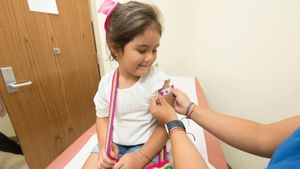Vitiligo, characterized by depigmentation of the skin due to the loss of melanocytes, has long been recognized as not just a cosmetic concern but a genetic and autoimmune disorder. Recent research conducted at King Saud University sheds new light on the role of genetic variants associated with this condition, particularly focusing on the CTLA4 gene. This gene encodes proteins integral to the regulation of immune responses, which can be affected in autoimmune diseases like vitiligo.
Despite its prevalence of less than 2% worldwide, vitiligo's social and psychological impacts can be monumental, often leading to stigmatization of those affected. The study aimed to investigate whether single nucleotide polymorphisms (SNPs) within the CTLA4 gene—specifically rs231775 and rs3087243—are associated with vitiligo among Saudi individuals. With historical data indicating varying prevalence rates within the Saudi population, the researchers focused on 300 individuals diagnosed with vitiligo compared against healthy controls.
The study’s methods involved extracting genomic DNA from participants and performing polymerase chain reaction (PCR) along with restriction fragment length polymorphism (RFLP) analysis. These techniques allowed the team to verify the presence of specific SNPs, and results from the analysis pointed toward noteworthy genetic associations. The findings revealed rs3087243 to be significantly linked to vitiligo, as confirmed by the statistical analyses conducted.
According to the study, "This study confirms rs3087243 SNP was associated with vitiligo in the Saudi Population," indicating the gene's pivotal role as part of the immune system's responses among affected individuals. Notably, the genetic profile within the patient group presented various allelic frequencies, with certain genotypes showing elevated risk rates when juxtaposed with control participants.
Demographic insights from participants also revealed important family and social factors. Approximately 30% of those with vitiligo had family histories of the condition, underscoring the hereditary nature of this disorder. Addressing the social perceptions and psychological impacts of vitiligo, the researchers acknowledged how such conditions could be compounded by societal stigma. “A family history of vitiligo is significantly linked to specific HLA haplotypes,” they noted, stressing the interplay between genetics and environmental factors.
The analysis of rs231775 did reveal some associations, albeit to a lesser degree compared to rs3087243. The team noted, “Patients with vitiligo often exhibit aberrant immune responses, which has led some people to speculate about the condition’s autoimmune component.” Given the autoimmune backdrop of vitiligo, these genetic insights are valuable not only for scientific inquiry but also for potential therapeutic directions.
While the research provides noteworthy contributions to the genetic mapping of vitiligo, the researchers call attention to certain limitations within the study. Public awareness and attitudes toward vitiligo remain limited, with previous surveys indicating gaps in knowledge. Increasing the general public's comprehension of vitiligo may alleviate social stigma and improve the lives of those affected.
With confirmed links between specific genetic variants and vitiligo outcomes, this study paves the way for future genomic research aimed at elucidation for both treatment and familial genetic counseling. Researchers hope these findings will inspire larger collaborative studies to provide broader insights applicable to diverse populations affected by this condition.



